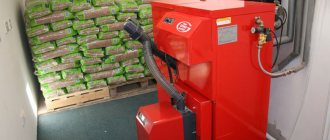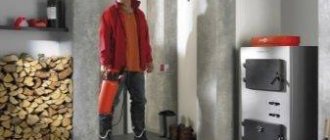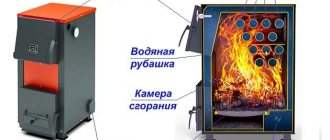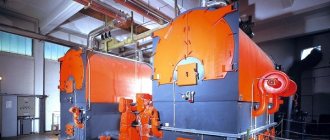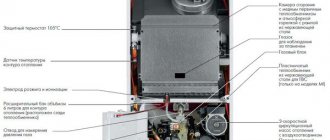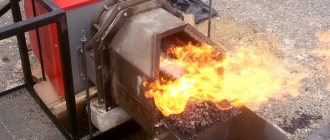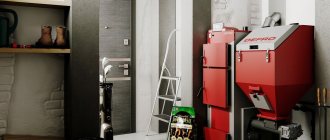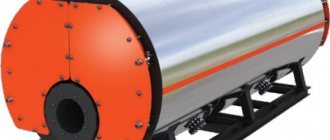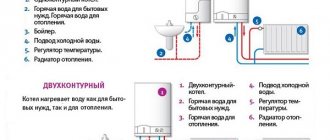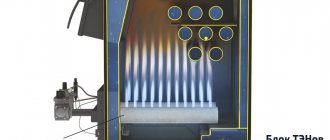Having become not so rare over the past few years, automatic coal boilers, however, for many still remain something beyond understanding. And it’s not surprising - a coal boiler and suddenly an automatic one ! Just a few years ago, this term would have puzzled most owners of private houses and cottages. But let's get back to the present. So, what is an automatic coal boiler ...
- Description
- Operating principle
- Control
- Advantages
- Model differences
Short description
The fundamental difference between automatic coal boilers and the traditional ones that are familiar to all is that all functions for controlling the operation of the boiler itself and the heating system - maintaining the set temperature in the house, maintaining the temperature of heated floors and hot water, automatic fuel supply, operation of the forced-air fan, operation of the pumps and mixing valves, transition of the boiler to support mode and back to operation mode, etc. — takes over the boiler controller. It is he who is responsible for a comfortable temperature in the house, minimizing boiler maintenance, ease of control, economical fuel consumption, high environmental friendliness and complete fuel combustion. It is thanks to modern automation of DEFRO boilers that record battery life, safety, efficiency and maximum efficiency are achieved.
Of course, the design of automatic boilers has a number of significant differences, which can be most easily understood by familiarizing yourself with the principle of operation of the boiler
Operating principle of automatic coal boiler
The operating principle of such a boiler is based on the automated supply of fuel, in our case coal, into the combustion chamber. And as a result, the design of such a boiler must contain, at a minimum, a mechanism for supplying fuel to the combustion area and a place for its storage. The first distinctive features of an automatic boiler are responsible for this - the feeding mechanism itself, and depending on the fraction and quality of the coal, it can be different (see screw feed and piston feed), as well as the fuel bunker, which stores a certain supply of coal, enough which on average lasts 3-7 days of continuous operation.
To ensure the required intensity and completeness of coal combustion, the automatic boiler is equipped with one or two (depending on the model and power) forced-air fans, the rotation speed of which, as well as the frequency of coal supply to the burner, is controlled by the microprocessor controller mentioned above - a kind of brain of the entire heating system of the house, without which no automatic heating boiler can do.
As a result, at the same time, a strictly calculated amount of fuel burns in a thin layer on the burner - the final necessary element of an automatic boiler, after which, after the next signal from the controller, the feed mechanism supplies the combustion zone with a new portion of coal. It is thanks to a balanced approach to the simultaneous supply of a small amount of fuel that complete combustion and high operating efficiency of an automatic coal boiler are achieved.
It is worth noting that, as in the case of the feed mechanism, each type of coal fuel has its own burner. For automatic coal boilers, for which it is supposed to use eco-pea coal (5-25 mm) as the main fuel, this is a retort burner. For boilers that will use “eco-peas” (5-25 mm) with a high (up to 60%) content of coal (fine coal) as the main fuel, this is an AKM type burner.
You can put together the information received and present the overall picture of the operation of an automatic boiler quite easily by watching a short information video once:
Features of wood boilers
Wood-burning boilers come in many varieties with many differences. Thus, the difference may lie in design features, material of manufacture, dimensions of the combustion chamber and less significant details.
The heat exchanger of a wood-burning boiler is usually made of cast iron or steel - both materials are good in their own way, although they are not without their drawbacks. Cast iron heat exchangers operate much more stable, warm up well and then release heat for a long time. The service life of such devices is quite long, but it can be significantly reduced due to sudden temperature changes in the boiler.
Heat exchangers made of steel have a service life of about 10-15 years versus 20 years for cast iron. Steel elements survive temperature changes much more easily, but wear out an order of magnitude faster during normal operation. In addition, steel is negatively affected by corrosion.
Speaking about long-burning boilers, it is worth noting a number of operational features:
- Carbon monoxide, which is produced when burning wood, is also used as fuel, due to which the period of operation of the boiler on one load is significantly increased;
- The coolant heats up unevenly;
- The combustion intensity can be changed manually by increasing or decreasing the air supply;
- Burning fuel leaves behind a lot of soot deposits and ash;
- A solid fuel wood boiler can only be connected to a properly equipped chimney;
- Firewood must be sufficiently dry, otherwise the efficiency of its processing by the boiler will be significantly reduced;
- The boiler must be installed at a certain distance from any objects present in the room, especially flammable ones;
- To store firewood, you have to allocate a separate place, and its area must be quite large.
The advantages of long-burning wood boilers can be expressed in the following list:
- Quite high efficiency and the ability to adjust the temperature of hot water supply;
- Possibility of using different fuel options (this rule does not work for all boiler models);
- Full autonomy of the boiler, i.e. you don’t need to connect to any communications for it to work;
- Possibility of heating premises for various purposes;
- Cheap fuel.
Control
With DEFRO automatic coal boilers, control by the owner is reduced to indicating the required room temperature or coolant temperature, as well as, if provided by the room heating system, the temperature of hot water and/or heated floors. It is possible to select a preset operating mode (for example, “DHW Priority”), as well as scheduled operation. Everything else is the work of the control controller itself, which provides the required temperature in the corresponding control circuits, the required fuel supply and air pressure, as well as control of the pumps and mixing valve.
You can find out more about the operation of the automatic coal boiler controller in the corresponding article - “Controller functions. Flexible control of the heating and hot water system.” .
Advantages of automatic coal boilers
In addition to the high efficiency of automatic coal boilers, in comparison not only with electric or liquid fuel boilers, but also with traditional coal ones, DEFRO automatic coal boilers have a number of other, no less important advantages, the most significant of which include:
- Reliability and durability. The reliability of DEFRO boilers can be judged at least by their weight. Outperforming their closest “competitors” in this indicator by 1.5-2.5 times, DEFRO boilers not only provide excellent heat transfer efficiency, but also guarantee a minimum service life. Agree, boiler steel with a thickness of 5-8 mm is much more difficult to burn out than a heat exchanger, the thickness of which often does not exceed 3-4 mm.
- Simplicity and ease of maintenance. The ease of servicing DEFRO automatic coal boilers has already been mentioned more than once by the owners of these heat sources themselves, so perhaps it will be enough to mention once again that the time taken for this not the most pleasant task with DEFRO automatic coal boilers ranges from 7 to 10 minutes a week.
- A level of comfort not achievable with traditional coal boilers. Boiler maintenance 1-2 times a week, room and GSM control, accuracy of the temperature set for the room up to 1 degree, full automation of the heating and hot water supply process (if there is an indirect heating boiler) - simple and necessary components of a high level of comfort for any owner of a country house properties provided by any DEFRO automatic boiler.
- Environmental friendliness and cleanliness. Automatic coal boilers DEFRO in their homeland in Poland were nicknamed “clean coal boilers” not only due to the complete absence of any smoke from the chimney exhaust pipe, but also because in the boiler room where the automatic DEFRO boiler is installed, there are never traces of soot, and, as a rule, the relative cleanliness for this kind of premises remains much longer.
Automatic boilers: design and advantages
Note: An automatic coal boiler differs from a conventional boiler in the presence of additional devices. Automatic controllers free people from the need for control, and also increase efficiency and reduce coal consumption and the amount of ash generated.
Automatic coal boilers
What does automation do:
- Control and supply of coal to the furnace. The design of the unit has a filling hopper with an auger (or drum) for automatic fuel supply. In this case, it is enough for a person to replenish the supply of coal in the bunker once every few days (from 3 to 10).
- Control and supply of air to the combustion zone. Controlled supply and preheating of the air mixture also ensures uniform fuel combustion and efficient operation of the device. An automatic unit has a fuel combustion efficiency of 90% (for comparison, a stationary coal stove has an efficiency of 60%, a classic boiler has an efficiency of 70%).
- Automatic ash discharge by movable grates.
The autonomous operating mode of the unit is determined by the specified parameters. The owner of the house sets the temperature for heating the liquid and the temperature inside the room. In accordance with them, the automation activates combustion or maintains smoldering mode (up to 5 days). Continuity of combustion allows ignition to be done once per heating season.
Powerful automatic coal boiler
How does automation work? Based on an analysis of the temperature inside the boiler and in the coolant tank, the pressure value, commands are sent to the air supply controller. Increasing the rate of its supply or decreasing it leads to increased combustion or its weakening. Which in turn regulates the heating temperature of the liquid inside the heat exchanger.
Automatic controllers operate on electrical energy. Therefore, boilers with automation are called volatile. They require a source of electricity (socket, battery).
Defro automatic coal boiler range
Coal heating devices are 20-40% more expensive than wood heating devices. But the use of automation allows you to reduce heating costs. Customer reviews confirm that savings in coal consumption in some automatic boilers reach 50%. This makes coal heating beneficial for individual residential buildings, workshops, workshops and other separate premises.
Scheme of a solid fuel boiler with automatic coal supply
